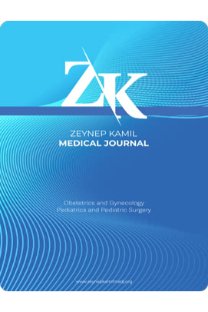Normal gelişimini tamamlamış insan plasentasında CD31, HCG ve estrojene spesifik reseptörlerin immunohistokimyasal yöntemlerle gösterilmesi
Antijenler, CD31, İmmünohistokimya, Östrojenler, İmmunoenzim teknikleri, Koryonik gonadotropin
Immunohistochemical demonstration of CD31, HCG and receptors for estrogene on normal human placenta at term stage
Antigens, CD31, Immunohistochemistry, Estrogens, Immunoenzyme Techniques, Chorionic Gonadotropin,
___
- 1.İto HH, Doughas GQ Qiu QF, Thirkill TL, Overstreet JW, Lasley BL. The relationship between trophoblast differentiation and the production ofbioactive HCG. Early Pregnancy. 1997; 3(4): 291-300
- 2.Al-Lamki RS, Stepper JN, Burton GJ. Are human placental bed giant cells merely aggregates of small mononuclear trophoblast cells? An ultrastructural and immunocy to chemical study. Hum Reprod. 1999;14(2):496-504
- 3.Kovalevskaya G, Genbacev O, Fisher SJ, Caceres E, O' Connor JF . Trophoblast origin of hCG isoforms: cytotrophoblasts are the primary source ofchoriocarcinoma-like hCG. 2002;194(l-2):147-55
- 4.Barros JS, Baptista MG, Bairos VA. Human chorionic gonadotropin in human placentas from normal andpreeclamptic pregnancies. Arch Gynecol Obstet. 2002; 266(2): 67-71
- 5.Kayisli UA, Selam B, Guzeloglu-Kayisli O, Demir R, Arici A. Human chorionic gonadotropin contributes to maternal immunotolerance and endometrial apoptosis by regulating Fas-Fas ligand system. JImmunol. 2003 ;171(5):2305-13
- 6.Yoshida Y. Secretion of human chorionic gonadotropin in erly pregnancy. Med Mol Morphol. 2005; 38(2): 104-11
- 7.PijnenborgR, VercruysseL, VerbistL, VanAssche FA. Interaction of interstitial trophoblast with placental bed capillaries and venules of normotensive and pre-eclamptic pregnancies. 1998;19(8):569-75
- 8.Challier JC, Carbillon L, KacemiA, Vervelle C, Bintein T, Galtier M, Espie MJ, Uzan S. Characterization of first trimester human fetal placental vessels using immunocy to chemical markers. Cell Mol Biol(Noisy-le-grand). 2001; 47 9.Nakagawa Y, Fujimoto J, Tamaya T Placental growth by the estrogen-dependent angiogenic factors, vascular endothelial growth factor and basic fibroblast growth factor, throughout gestation. 2004;19(5):259-66
- 10.Bukovsky A, Caudle MR, Cekanova M, Fernando RI, Wimalasena J, Faster JS, Henley DC, Elder RF. Placental expression of estrogen receptor beta and its hormone binding variant-comparison with estrogen receptor alpha and a role for estrogen receptors in asymmetric division and differentiation of estrogen-dependent cells. Reprod Biol Endocrinol. 2003, 1: 36
- 11. Bukovsky A, Cekanova M, Caudle MR, Wimalasena J, Foster JS, Henley DC, Elder RF. Expression and localization of estrogen receptor-alpha protein in normal and abnormal term placentae and stimulation of trophoblast differentiation by estrodiol. Reprod Biol Endocrinol. 2003;l:13
- 12.Sonoda N, Katabuchi H, Tashiro H, Ohba T, Nishimura R, Minegishi T, Okamura H. Expression of variant luteinizing hormone/chorionic gonadotropin receptors and degradation of chorionic gonadotropin in human chorionic villous macrophages. Placenta. 2005; 26(4):298-307
- 13.Barros JS, Baptista MG, Bairos VA. Human chorionic gonadotropin in human placentas from normal and preeclamptic pregnancies. Arch Gynecol Obstet. 2002; 266(2): 67-71
- 14.Tertemiz F, Kayışlı UA, Arıcı A, Demir R. Apoptosis contributes to vascular lumen formation and vascular branching in human placental vasculogenesis. Biol Reprod 2005; 72(3): 727-35
- 15.M. Castellucci, G.Kosanke, F.Verdenelli, B.Huppertz and PKaufmann. Villous sprouting: fundamental mechanisms of human placental development.Hum Reprod Update. 2000; 6(5):425-94
- 16.KacemiA, Vervelle C, Uzan S, Challier JC. Immunostaining of vascular, perivascular cells and stromal components in human placental villi. Cell Mol Biol (Noisy-le-grand). 1999; 45(1): 101-13
- 17.Morrish D W, MarusykH. Localization of human chorionic gonadotropin and placental lactogen by immunogold labeling for electron microscopy technique and limitations. Microsc Res Tech. 1997; 38(1-2): 176-87
- 18.Kumar V, Green S, Stack G, Berry M, Jin JR and Chambon P. Functional domains of the human estrogen receptor. Cell 1987; 51:941-951
- 19.Luo D, Liu SY, Xing AY. Expression and localization of estrogen receptor ERalpha and the kinds ofERbeta mRNA on placenta. Sichuan Da XueXueBao YiXueBan. 2006Sep;37(5):769-72
- 20.Al-Bader MD.Estrogen receptors alpha and beta in rat placenta: detection by RT-PCR, real time PCR and Western blotting. Reprod Biol Endocrinol. 2006 Mar28;4:13
- ISSN: 1300-7971
- Yayın Aralığı: 4
- Başlangıç: 1969
- Yayıncı: Ali Cangül
Ranan Gülhan AKTAŞ, Naciye ARAT, HANDAN ANKARALI, Kenan SOFUOĞLU, Tansel ÇETİNKAYA, BELGİN DEVRANOĞLU, Arman ÖZDEMİR, SELÇUK AYAS
Benign görünümlü over kistlerinde abdominal sonografi ile kist aspirasyonu
Özgür DÜNDAR, KEMAL YILDIZ, Levent TÜTÜNCÜ, Ercüment MÜNGEN, Vedat ATAY, ARİF AKTUĞ ERTEKİN
Doğal ve cerrahi menopoz olgularındaki hormonal değişimin kemik döngüsüne etkisi
Berna HALİLOĞLU, Fehime Benli AKSUNGUR, Aygen ÇELİK, ERDİN İLTER, Figen Temelli AKIN, Ümit ÖZEKİCİ
Ovaryan intermediate grade sertoli-leydig hücreli tümör, germ hücreli komponent; olgu sunumu
Murat Hakan KARABULUT, Müberra Seğmen YILMAZ, Gözde KIR, Ahmet GÖÇMEN, Billur COŞAN, Filiz ALPTEKİN
Barış MÜLAYİM, Zeki ŞAHİNOĞLU, Sema MÜLAYİM, Habibe AYVACI, Umur KUYUMCUOĞLU
Makroglossi ve ağız boşluğu kütlesi olan fetusde prenatal tanı ve perinatal yönetim
Sibel Sürmen USTA, Cemalettin ÖZARPACI, Habibe AYVACI, Bülent TANDOĞAN, Kadriye ZEHİR
Kızamıkçık ve hepatit B aşısı sonrası görülen bir Guillan-Barre sendromu olgusu
Levent MDYAT, Aşan ÖNDER, Gabil MURSALOV, Yasemin ÖZDEMİR, Sevgi MİR
Ranan Gülhan AKTAŞ, AYNURE ÖZTEKİN, Ülkü BAYAR, COŞKUN ÖZTEKİN
Endometrium ve overin eş zamanlı endometrioid tipte adenokarsinomu / iki olgu sunumu
Müberra Seğmen YILMAZ, Murat Hakan KARABULUT, Gözde KIR, Ahmet GÖÇMEN, Ayşe Nur İHVAN, Filiz ALPTEKİN
Müferret ERGÜVÜN, Ümit AKYÜZ, Şirin GÜVEN, Fuat LALOĞLU, Olcay BİLGİÇ
